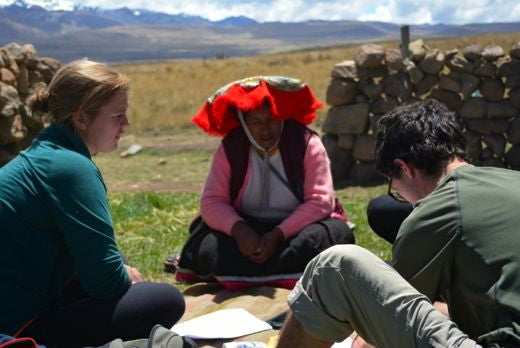
Evaluation Research Interns Harrison and Annie have been busy working since July on administering Threads of Peru’s first evaluation project.
Although each community that Threads partners with is unique, the goal of conducting a socio-economic operational evaluation involving all 80 or so weavers is to better understand the artisans individually, as associations, and as a whole group. Understanding how Threads of Peru collaborates with each of the five communities will allow for future adaptations, intended to improve organizational effectiveness. While this initial baseline research is the first research of its kind being implemented by Threads of Peru, resulting conclusions will assist in decision making and program direction in the years to come.

Annie and Johnny interview Paulita Sicos Huaman of the Puca Turpay weaving association, located in the community of Rumira Sondormayo. Photo credit Harrison Ackerman.
The research strategy involves the exploration of social and economic topics through a basic three-part interview which has been conducted with almost all partnering weavers. The interviews have been structured with three parts, including (I) an ethnographic survey, (II) a “defined” economic survey, and (III) a “hypothetical” economic survey. The ethnographic survey is enabling the development of comprehensive artisan profiles to better understand who the artisans are, the “defined” economic survey is highlighting the specifics of weaver income and expenses, and the “hypothetical” economic survey is exploring weaver ambitions and how Threads of Peru is affecting their achievement. Now that the team is nearly completed with two months of data collection, their analysis will soon begin and ultimately result in a thorough research report.

Harrison and Adrian engaged in an interview with a member of the Ticllay Huarmi association, located in the community of Chaullacocha. This was the largest association with which the team collaborated for this project. Photo credit Dana Blair.
After sitting down and conversing with almost all the artisans, Harrison and Annie have learned a great deal, ranging from individual-specific information to trends that apply across the entire data set. The baseline ethnographic component has helped the team better understand weaver ages, places of birth, civil statuses, levels of education, degrees of Spanish language and literacy, and families. The ¨defined¨ economic section has revealed important nuances and preferences regarding the weaving process along with breakdowns of family income and expenses. Lastly, the ¨hypothetical¨ economic section has highlighted weaver desired family incomes, opinions about leaving their communities, and weaver ambitions across a variety of topics.

Harrison and Annie pose for a pic with the weaving association in Uppis. They interviewed a total of 17 women over three trips to this community. Photo Credit Johnny Huaman.
As the team shifts their attention toward organizing and analyzing the vast amount of data that is now collected, Harrison and Annie will be working to identify trends, outliers, and valuable case studies. Such information will be used to more acutely explain Threads of Peru’s work and also form recommendations for future project adaptation. Results and conclusions drawn from this research will help Threads maintain complete transparency in its work and ensure that the organization is constantly adapting to meet the pressing needs of the communities supported.
Article by Harrison Ackerman

